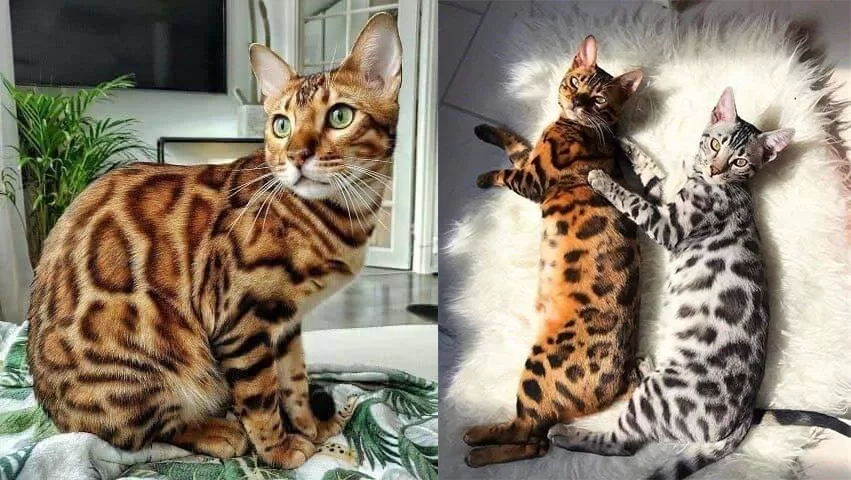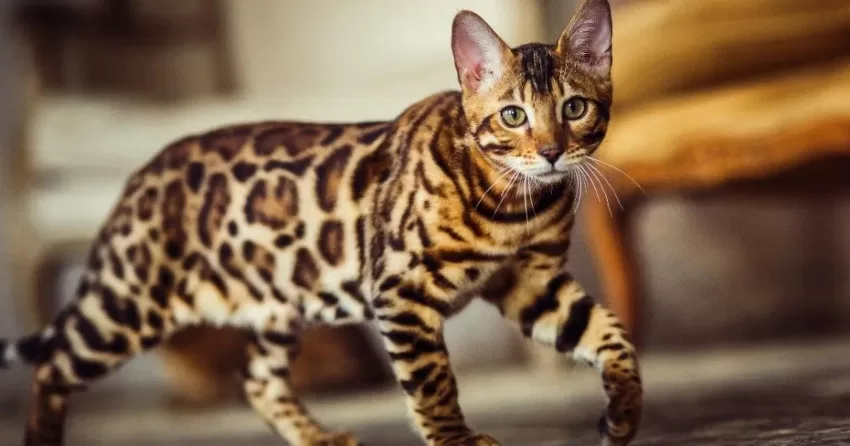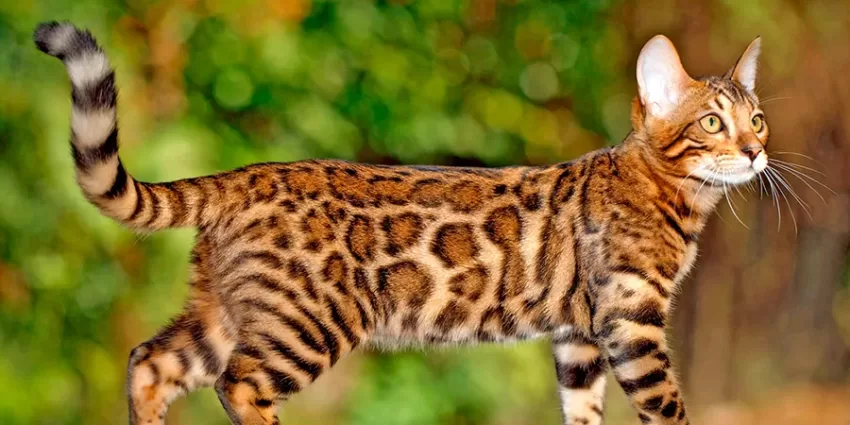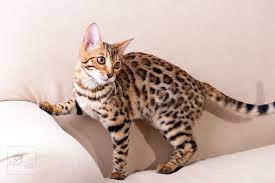Introduction to the Bengali Cat: characteristics, personality and health
Have you ever heard of the Bengali leopard cat? If not, get ready to meet a wild feline breed that is increasingly conquering pet lovers. With its exotic and elegant appearance, it is known for its spotted fur, which resembles that of a leopard in the great wilds.
Originating from selective breeding between domestic felines and the Asian leopard cat, this hybrid impresses with its piercing eyes and graceful profile. Also, Bengali cats are small in size but big in personality. No wonder they are becoming very popular as pets.
If you are thinking about having one as a companion, know that they are great for anyone looking for an active and playful pet. They have an inexhaustible source of energy! So, if you are looking for a feline that is different and full of life, consider adopting one of these incredible specimens.
Priscila is an expert on the subject and tells us everything about the Bengali cat breed . She finds out how long this breed has been around, what different types of coats are found on these animals, and much more. Stay tuned for the next information about these adorable felines!
Origin and kinship of the Bengali cat with the leopard
It is a fascinating feline that originates from the cross between the domestic cat and the Asian leopard. This breed was first created in the 1960s in the United States through a selective breeding program. The aim was to develop a new lineage of cats with unique genetic traits inherited from leopards.
The origin of the Bengali cat is based on the idea of combining the exotic beauty of leopards with the friendly and domesticated personality of domestic cats. The breeders sought to create a breed that was visually impressive, but also had a docile temperament and adaptable to living in familiar environments.
As a result of this careful breeding, the Bengali cat inherits striking physical traits from leopards, such as its spotted coat, which resembles the spots found on these wild cats. In addition, they have an agile and muscular body structure, typical of the leopard subspecies.
Selection for pedigree:
However, despite these obvious physical similarities, it is important to point out that it is a completely different species from the Asian leopard in terms of behavior and needs. They are domesticated animals and do not have the predatory instincts as strong as wild leopards.
The creators used several techniques to ensure that these desired results were obtained. Careful selection of individuals with the best genetic traits was essential to ensure that the cubs inherited the desired characteristics of leopards, but also maintained a friendly and sociable temperament.
It has a unique pedigree, which records each animal’s lineage and traces its ancestry back to Asian leopards. This registration is important to guarantee the purity of the breed and to avoid undesirable crossings that could compromise the physical and behavioral characteristics of the cat .
In summary, the Bengali leopard cat originated from the cross between the domestic cat and the Asian leopard in the United States in the 1960s. This breed has unique genetic characteristics inherited from leopards, such as a spotted coat and an agile body structure. However, despite these striking physical similarities, they are domesticated animals with a docile temperament and adapted to living in familiar environments. The pedigree is used to record the lineage of these cats and ensure the preservation of their distinctive characteristics.
Physical characteristics of the Bengali cat

The Bengali leopard cat is a feline breed known for its unique and impressive physical characteristics. From their coat to their body size and shape, these cats are truly endearing. In summary in this article, we will explore in detail the physical characteristics that make this feline one of the most fascinating breeds.
Smooth, short, shiny coat with distinctive spots or rosettes
One of the first things you notice about the Bengali cat is its lush and distinctive coat. Its skin is covered with short, soft, shiny hairs that feel pleasant to the touch. However, what really sets this breed apart are the spots or rosettes present on the coat.
The spots can vary in size and shape, much like leopard spots. They can be large or small, rounded or elongated, giving the feline a wild look. The combination of the base coat color – usually golden brown – and the black markings creates a striking contrast that makes the Bengali cat unmistakable.
Athletic, muscular and slim body
However, in addition to the unique coat, another striking feature of Bengali cats is their athletic and muscular body. These cats have an elegant and slender body structure, with long and strong limbs that give them an agile and graceful appearance. So their physical size is the result of a combination of genetic factors and careful selection over the years.
Thanks to this muscular structure, Bengali cats are excellent jumpers and climbers. They have great ease in moving in different environments, whether indoors or outdoors. This natural agility is a reflection of its wild ancestry, as the Bengal cat is based on a cross between domestic cats and Asian leopards.
Large, expressive eyes, usually green or gold
The Bengali cat’s eyes are true windows to its captivating soul. Usually large and expressive, they mesmerize anyone who looks closely at them. Eye color varies between individuals, but it is common to find shades of green or intense gold.
This unique combination of spotted fur and vibrant eyes gives Bengali cats a special charm.
Bengali cat behavior
Bengali cats are known for their unique and fascinating behavior. These exotic felines, also known as “leopard cats”, have distinctive characteristics that make them very special pets. So let’s explore some of the main characteristics of the behavior of these lovely felines.
Energetic and playful, it loves to have fun with its owners.
It’s a pet-shaped ball of energy. Plus they are extremely active and love to play. If you are looking for a companion to accompany your daily activities, the Bengali cat may be the perfect choice for you.
These cats have a constant need to move around and have fun. They are great jumpers and climbers, so be sure to provide them with lots of interactive toys, scratching posts and trees to climb. Also, make time every day to play with your Bengali cat – playing balls or chasing feathers are activities they love!
Intelligent and curious, always exploring their environment.
Another striking feature of the Bengali cat’s behavior is its remarkable intelligence. These cats are incredibly smart and are always ready to learn new things. Therefore they have a natural instinct to investigate everything around them and are constantly exploring their environment.
To keep a Bengali cat happy, it is important to provide mental stimulation. Toys that challenge their intelligence, like food puzzles, are a great option. Also, allow your Bengali cat to explore different areas of the house and offer new things for him to discover regularly.
Can be vocal and communicative to get attention.
Bengali cats are known for their ability to communicate with their owners in unique ways. Additionally, they can be quite vocal when they want to get attention or express their needs. These cats have a wide range of sounds – from soft meows to loud growls – and each sound has a different meaning.
When your Bengali cat is vocalizing, pay attention to the signals it is transmitting. It could be that he is hungry, wanting to play, or simply looking for affection. However, learning to understand your cat’s language will help strengthen the bond between you and ensure that all of your cat’s needs are met.
Health and necessary care for the Bengali cat

The leopard Bengali cat is a generally healthy breed, but like any other pet, it needs special care to ensure its well-being. In this article, we are going to cover the main aspects related to health and the necessary care to keep a Bengali cat happy and healthy .
Propensity to genetic diseases
Although the Bengali cat is known for its stamina and stamina, it can be prone to certain genetic diseases. Therefore, it is important to be aware of these conditions in order to be able to identify them early and seek appropriate medical treatment.
Some of the more common illnesses that can affect Bengali cats include:
- Hypertrophic cardiomyopathy : a condition where the walls of the heart become thickened, making it difficult for blood to pump properly.
- Hip dysplasia : A malformation in the hip joint that can cause pain and difficulty moving.
- Polycystic kidney disease : an inherited condition in which cysts form in the kidneys, which can lead to serious kidney problems.
It is essential to carry out regular veterinary consultations to monitor the health of your Bengali cat and carry out preventive examinations. Also, when purchasing a Bengali kitten, make sure the parents have been tested for these genetic diseases.
Regular exercise to prevent boredom and unwanted behaviors
In fact, the Bengali cat is an active and energetic breed that needs physical and mental stimulation to stay healthy. It is essential to provide your Bengali cat with regular activities to avoid boredom and possible unwanted behavior.
Some exercise options that may be beneficial for your Bengali cat include:
- Interactive Toys : Offer toys that encourage hunting, such as stuffed mice or games with rewards.
- Cat Tree : Install a tree with platforms and scratching posts, allowing your cat to jump, climb and scratch.
- Supervised walks : if possible, take your Bengali cat for walks in a safe garden or use a specific collar for cats.
So remember to always supervise your Bengali cat’s activities during exercise and adapt them to his individual needs.
Proper diet for the Bengali cat

The Bengali cat is a breed of feline known for its exotic appearance, reminiscent of a small leopard. In addition to their unique beauty, these cats also have specific needs when it comes to food. Therefore, an adequate diet is essential to ensure the health and well-being of your Bengali cat.
Balanced diet with specific quality feed for feline breeds
One of the main ways to provide a balanced diet to your Bengali cat is through the use of feed formulated specifically for feline breeds. In addition, these feeds are developed taking into account the nutritional needs of cats and can help prevent health problems associated with inadequate food.
When choosing a pet food for yours, make sure it contains high quality ingredients such as meat or fish as the main source of protein. Avoid products that contain animal by-products or artificial ingredients. Also, make sure the kibble is balanced in terms of essential vitamins and minerals.
Avoiding raw or homemade foods that can cause nutritional imbalances
Although it is tempting to offer homemade or raw food to your Bengali cat, it is important to avoid this practice. Raw food can contain harmful bacteria that can cause gastrointestinal illness in cats. Also, they may not provide all the nutrients needed for a balanced diet .
Likewise, homemade foods may not meet the specific nutritional needs of Bengal cats. It is difficult to ensure that homemade food provides all essential nutrients such as protein, vitamins and minerals in adequate amounts. Therefore, it is recommended to opt for foods formulated specifically for cats.
Offer fresh, clean water daily
In addition to providing adequate food, it is also essential to ensure access to fresh, clean water on a daily basis. On the other hand, adequate hydration is essential for the feline’s kidney and general health.
So make sure you change your cat’s water regularly to avoid the proliferation of bacteria or other contaminants. Placing more than one container of water around the house can encourage frequent consumption.
In conclusion, offering your Bengali cat an adequate diet is essential to ensure its health and well-being.
Where to buy a Bengali cat?

Searching for the ideal place to buy one can seem like a daunting task, but with the right information and a few precautions, it is possible to find a responsible breeder that will provide healthy, well-cared-for puppies. In this article, we are going to discuss some important tips to help you in this quest.
Responsible and Registered Breeders
When deciding to buy a Bengali cat, it is recommended to look for responsible and registered breeders. These breeders follow ethical breeding standards, ensuring the health and well-being of the animals. In addition, they often possess specialized knowledge of the Bengali leopard breed.
So to find these breeders, you can start your search at recognized feline associations. These organizations usually have lists of trusted breeders who meet established requirements for responsible Bengali cat breeding.
Origin of the Puppy and Breeding Conditions
Before closing a deal with any breeder, it is essential to verify the origin of the puppy and the conditions in which it was raised. So be sure to visit the site in person or ask for up-to-date photos of the environment where the cats are kept.
During the visit or analysis of the images, observe that the animals have enough space to move freely. Check the premises for signs of proper cleanliness. In addition, it is important to ensure that cats receive adequate food and regular veterinary care.
Adoption
However, in addition to the purchase option, adoption is also a valid alternative for those who wish to have a Bengali cat. There are shelters and rescue organizations that may have cats of this breed available for responsible adoption.
In short, by adopting a Bengali cat, you are giving a second chance to an animal that needs a loving home. Many of these cats have been abandoned or rescued from precarious situations, and by adopting them, you will be making a difference in their lives.
Final considerations
Finally, when deciding to buy or adopt one, it is important to remember to look for responsible and registered breeders, to verify the origin of the puppy and the conditions in which it was raised. Adoption is also an option to consider, helping animals that need to find a new home.
Always remember to dedicate enough time to research the subject before making any decision.
Conclusion on the Bengali leopard cat
The leopard Bengali cat is a fascinating breed that arouses interest in many people. In this brief conclusion, we will summarize the main points discussed earlier to help you better understand this breed and make informed decisions.
- Origin and kinship of the Bengali cat with the leopard: The Bengali cat originates from the cross between domestic felines and Asian leopards. This mixture resulted in an exotic animal, with spots similar to those of a leopard.
- Physical characteristics of the Bengali cat: The Bengali cat has a beautiful and shiny coat, with colors ranging from shades of brown and gold. Indeed, His body is muscular and athletic, much like wild leopards.
- Bengali cat behavior: These cats are known to be very active, curious and intelligent. They love to play, climb and explore their surroundings. In addition, they are affectionate animals that enjoy human company.
- Health and necessary care for your Bengali cat: Just like any other pet, regular veterinary care is essential to ensure the health of your Bengali leopard cat. It is important to keep their vaccines up to date, provide a balanced diet and provide a safe environment.
- Proper diet for Bengali cats: Bengali cats have specific nutritional needs, so it is essential to offer them a balanced and quality diet. Consult a veterinarian for advice on the most appropriate food for your pet.
In summary, the Bengali leopard cat is a unique breed that combines exotic beauty with an endearing personality. So if you are prepared to provide the necessary care and dedicate time to your new feline friend, you will have a rewarding experience living with this wonderful breed.
Common questions
WHAT IS THE LIFE EXPECTANCY OF A BENGALI LEOPARD CAT?
The average life expectancy of the leopard Bengali cat ranges between 12 and 16 years when properly cared for.
IS THE BENGALI LEOPARD CAT SUITABLE FOR APARTMENTS?
Although they are active, Bengal cats can adapt well to apartments as long as they have enough space to play and exercise.
DO I NEED TO BRUSH MY BENGALI LEOPARD CAT’S COAT REGULARLY?
Yes, brushing your Bengali leopard cat’s coat regularly helps to remove dead hair and keep its coat shiny and healthy.
IS THE BENGALI LEOPARD CAT AN AGGRESSIVE BREED?
No, the leopard Bengali cat is not naturally aggressive.
External References:
«Animal Health – Virtual Zoo – ASIAN LEOPARD»

